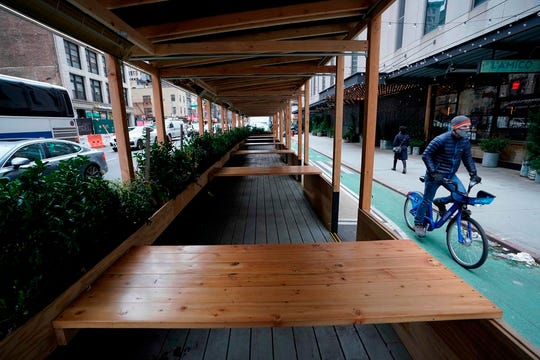Gov. Andrew Cuomo has announced that indoor dining restrictions will be reinstated in New York City on Monday, as coronavirus cases and hospitalizations continue climbing in the city and throughout the state. (Dec. 11) AP Domestic
NEW YORK – Billy Cole said the restaurant has lost tens of thousands of dollars since the start of the pandemic, if not $100,000.
Workers have been furloughed and salaries cut at Little Dokebi, a Korean restaurant in Brooklyn’s Greenpoint neighborhood. Despite the losses, they’ve been one of the lucky ones because they’re on a corner with plenty of outdoor dining space, said Cole, the general manager.
Now, with a snow storm signaling the start of cold weather and a recently renewed ban on indoor dining, he knows it’s going to be almost exclusively takeout and delivery orders that drive business for the next several months.
“What’s a heater gonna do when it’s 30 degrees out and you’re 50% exposed any way,” Cole said.
Restaurants around the country have struggled for months to adapt to the COVID-19 pandemic, facing layoffs and pay cuts and investing in personal protective equipment and outdoor dining infrastructure all while some customers still haven’t returned.
However, the start of winter weather portends what could be an even darker few months for the dining industry in New York and across the country as restaurants struggle to balance safety measures for their patrons and staff with meeting their bottom lines.
“We need to brace ourselves for an even worse period for the restaurant industry,” said Andrew Rigie, executive director of the New York City Hospitality Alliance.
According to the National Restaurant Association, sales have begun to dip again in the colder months after the summer saw some progress.
Restaurant sales were around $65 billion in the months before the pandemic but plummeted to just $30 billion in April, according to Census Bureau data. They peaked in September at $55.7 billion but have declined for two months in October and November.
This restaurant’s revenue is better than last year: How some owners can survive even in COVID-19 winter
One reason for the dip has been the closing of outdoor dining options, the National Restaurant Association said. From September to November, the number of full-service restaurants offering outdoor dining nationwide dropped by almost a quarter, while partial-service operators also saw almost a 15% decline in outdoor offerings.
“For many restaurants, outdoor dining was what was sustaining them through this crisis because they needed that revenue,” said Mike Whatley, the restaurant group’s vice president of state and local affairs. “But cold weather and especially the snow is a real challenge for the industry.”
On Wednesday, the nearly 11,000 restaurants participating in New York City’s outdoor dining program faced a new dilemma for this year: About a foot of snow forecast.
The Department of Sanitation, which operates the city’s snowplows, told restaurants that the structures many had built to house their outdoor seating could remain on the streets but that staff would have to bring in tables, chairs and electric heaters.
New York City’s restaurants also faced a new indoor dining ban that went into effect Monday as Gov. Andrew Cuomo reversed the policy that had allowed diners to eat inside since late September while operating at 25% capacity indoors. The rest of the state has indoor dining still operating at 50% capacity, except for areas with high COVID-19 rates, which drop to 25%.
Brooklyn Chamber of Commerce President Randy Peers described the snow, closing indoor dining and other COVID-19 restrictions as a triple whammy.
“We can’t control the weather, but we can control things like, do we shut down our economy, do we allow restaurants to open indoors and things like that,” Peers said. “It’s the worst possible timing for our restaurants and we’ll have to see how it all plays out, how long it lasts. But from an economic perspective, it’s a pretty dire situation.”
At Little Dokebi, Cole said staff partially deconstructed and lifted their structure onto the sidewalk ahead of the storm. That, in effect, closed their outdoor dining, which Cole said he doesn’t see coming back in the cold months.
He said the guidance from the city on what is and isn’t allowed has been “very vague and they’ve changed the rules too many times to count.”
When indoor dining was allowed, an outdoor structure that was more than 50% covered was considered extra capacity for the indoor operation. But now with indoor dining banned, Rigie said those restaurants have to open their structures by removing walls or lifting flaps if they want to still use them.
However, the danger comes with compliance. Dr. Isaac Weisfuse, a former deputy health commissioner at the New York City Department of Health and Mental Hygiene, said that when the cold weather picks up, diners may ask for the flaps on these open structures to close.
“What will the restaurant owner do when the patron requests that?”
‘Not all outdoor structures are created the same’
Outdoor dining may pose less risk of coronavirus transmission than indoor dining because there is greater ventilation outside, which dilutes the virus particles in the air more quickly, public health experts say. But outdoor dining is not risk-free.
“You can think about the virus as behaving in the air like cigarette smoke does,” said Dr. Linsey Marr, a professor of civil and environmental engineering at Virginia Tech. “If you have a few people at different tables smoking, think about what that does to the smoke if you have four walls and a roof, versus being out in the open air.”
Some outdoor dining structures may be safer than others, said Dr. Sadiya Khan, an epidemiologist and assistant professor of medicine at Northwestern University Feinberg School of Medicine.
“If a structure is created in such a way that it is an enclosed space, with heating and carpeting, it’s basically an indoor facility outside,” she said.
COVID-19 indoors: Ventilation and air filtration play a key role in preventing the spread
Like New York, many cities that permit outdoor dining placed restrictions on the number of walls or sides that must be open to retain ventilation.
Chicago requires temporary outdoor structures that hold multiple parties to have at least 50% of the sides open to allow for air flow, and enclosed structures are permitted for people living in the same household but must have adequate ventilation to allow for air circulation, according to city guidelines.
“Igloos” and mini tents can be seen on sidewalks and closed-off roadways throughout Chicago. Many restaurants require patrons to reserve spaces in advance, limit dining time to two hours or less and clean the structures between uses.
But experts were mixed about the safety of these individual dining experiences.
“The challenge is that the waiter would be coming in or out, or it’s possible that the person who dined there before you, even though they’re not there anymore, the virus in the air could still persist,” Khan said.
Weisfuse said these individual structures could provide a good way for people to eat out while doing so safely. If the igloos remained truly limited to one household and restaurants aired them out for 15 to 20 minutes between parties, it could be safer than some of the multi-table enclosed structures cities have seen built.
But like with most things in the pandemic, the particulars of a dining setup matter, he said. “You have to judge for yourself what the situation is.”
What’s the least risky option? Marr said that would involve tables spread out in the open air with patrons wearing face masks when not eating or drinking. Some restaurants nationwide are planning to take this approach over the winter by investing in bonfire pit tables that can be scattered on open patios. But these options may be more limited in cities like New York, where extra space is a hot commodity.
Contact tracing: Officials worry about virus spread at restaurants, but failed contact tracing leaves diners in the dark
There’s another factor for people to consider when they’re thinking about dining outside, experts said: Noise.
A May study found that loud talking could leave coronavirus particles in the air for up to 14 minutes, according to the Proceedings of the National Academy of Sciences.
“We know that talking louder releases more aerosols, so if there’s a lot of background noise and that forces someone to talk louder, that’s a riskier situation,” Marr said. “Keep things quiet, and hope that the people around you are quiet, too.”
It’s still unclear how much transmission at outdoor dining structures, specifically, is contributing to rising COVID-19 case counts, experts said.
In New York, spread in restaurants and bars accounts for less than 2% of all viral transmission while nearly 74% is through household and social gatherings, according to state contract-tracing data. In Illinois, where indoor dining has been closed since early November, restaurants and bars may account for nearly 6% of all COVID-19 exposures in the state, according to Illinois state data contract-tracing data.
California isn’t taking any chances. Last week, California Gov. Gavin Newsom issued stay-at-home orders and business shutdowns for regions at risk of running out of intensive care unit beds. A ban on indoor and outdoor dining is expected to run through at least Dec. 27.
“The most important thing that we’ve learned over the last year is that there is no zero-risk situation,” Khan said. “The only way to eliminate risk is to not dine at a restaurant.”
Restaurants are ‘teetering on the edge of survival’
At Modern Love, a vegan restaurant in Williamsburg, Sara Kubersky said the restaurant never reopened for indoor dining and has had counter service with a small outdoor structure for patrons on the street.
“Our guests pick up at the window,” said Kubersky, one of its owners. “We just thought it was safer for the staff and our guests as well.”
“If you are going to eat, the less people you interact with, the safer it is,” she added.
While the restaurant used to serve up a “swanky” menu closer to fine dining comfort food, they’ve pivoted to more of a “fast casual kind of restaurant,” focusing also on delivery and takeout.
New Yorkers enjoy eating outdoors but “when it gets cold you definitely see a drop in business,” she said.
More on restaurant industry during COVID-19: Your favorite restaurant or small business – as many as 36,000 – faces closure without coronavirus relief
Rigie, of the New York City Hospitality Alliance, said outdoor dining was “critically important” to keeping restaurants open during the pandemic as restaurants are “teetering on the edge of survival.”
“It brought a vitality and energy back to the city’s streets that was so important for our economic and social wellbeing,” he said.
Before the COVID-19 shutdowns, there were 325,000 industry jobs in the city. That plummeted to 90,000 in April, Rigie said. It has since ticked back up to 192,000 in recent weeks thanks to outdoor dining and the brief stretch of indoor service.
But with the weather and the dining ban, those 100,000 jobs that were brought back “are on the chopping block again,” Rigie added.
While Modern Love planned to keep its wooden structure in place during the storm, Kubersky wishes there was more aid from government sources to keep the restaurant industry afloat. From having to buy more take out containers to building their outdoor dining structure, the costs add up. “Our bottom line is affected. … Our sales haven’t quite hit to where they were.”
“Before I do anything much bigger with outdoor dining, I really want to see what happens in the winter,” she added.
Ryan Miller reported from New York City; Grace Hauck reported from Chicago; and Kelly Tyko reported from Coral Springs, Florida.



















